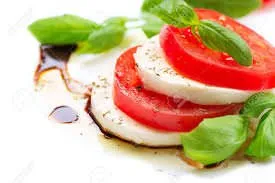La Caprese ... sweet or salty?

When we talk about Caprese we think of two dishes, one sweet and one salty, emblems of the homonymous island. On one side there is the popular cake with almonds and cocoa, worthy adversary of the intramontato sweet Anglo-Saxon based on nuts and chocolate; on the other, that cold appetizer par excellence, alternating slices of tomato slices of buffalo mozzarella DOP bell.

Leaving aside the sweet side of Caprese, we decided to focus on the salty side, transforming the most famous Neapolitan salad, paradigm of the Italian flag, into a lasagna.

First of all it is necessary to dwell on the origins of this dish, which, as with any classic, are controversial. Some entrust the birth to a particularly patriotic mason who loved to enclose the colors of our flag inside a sandwich. Others still reconnect it to a dinner at the Hotel Quisisana in Capri, in honor of Filippo Tommaso Marinetti. According to others, the Caprese was the protagonist of an event that even involved the sovereign of Egypt Farouk who, in 1951, during a stay in Capri, had the opportunity to taste a stuffed sandwich with the basic ingredients of this salad .
The Caprese purists will look at our revisit with a malicious eye and subject the tomato and mozzarella to the heat of the oven. And yet, not everyone knows that mozzarella is never eaten cold, but always warm, between thirty and forty degrees ... I can assure you that it's the end of the world! The same Francesco Apreda, a Michelin star, offers a revisitation of Caprese, "lukewarm, liquid and smoked", in which the eggs of Bufala are left at room temperature and then drowned in a Dashi (Japanese broth) of tomato. Inspired by the master, we try to work as little as possible in this spun dough cheese in order not to alter its taste.
According to tradition, then, the task of completing the taste of tomatoes and mozzarella would be the oregano, but we, for a moment detaching ourselves from the most conservative dogmas, we replaced the leaves of the classic aromatic herb with a light basil pesto. In fact, even the basil, as you all know, establishes a marriage of love with San Marzano. Because of its more delicate and less invasive flavor, it manages to satisfy the palate of everyone, even the youngest ones who, since the first year of age, are used to eating pasta with fresh tomato and basil sauce.
The interesting thing about basil pesto is that it has its roots in the Ligurian territory and therefore, together with the mozzarella and tomato, typically southern, traces the general profile of Italy. The green of the basilica of Prà, the white of the Campania mozzarella and the red of the San Marzano tomato evoke the beautiful country, not only from the chromatic point of view, but also and above all from a geographical and cultural point of view.
INGREDIENTS FOR 4 PEOPLE:
for the pastry:
- 3 medium eggs
- 300 gr flour 00
for pesto:
- 120 gr basil
- 10 gr pecorino cheese
- 40 gr parmigiano reggiano red cows 24 months
- 20 gr. Pine nuts
- 80 ml extra virgin olive oil
- Salt to taste
for the filling:
- 200 gr fior di latte
- 400 g cluster tomatoes
- 230 g béchamel sauce
- 270 gr pesto
- oil evo qb
- parmigiano reggiano red cows 24 months qb
METHOD:
For the dough: knead the ingredients by hand or with the planetary until obtaining a smooth and homogeneous result. Collect the dough in a ball, wrap it with the transparent kitchen film and let it rest for at least 1 hour in a cool place, covered with a tea towel.
Roll out the dough by hand or with the machine to a thickness of about 2-3 mm. Obtain them rectangles of dimensions just below those of the pan. Cook them in abundant salted water.
For the tomatoes: slice the tomatoes on one of the ends, blanch them for a few seconds in boiling water and then immediately dip them in water and ice so that they can more easily remove the peel and seeds by making a concasse. You will get some flakes that you have to leave to macerate a couple of hours with oil, salt and basil.
Break the milk with your hands and dry it lightly with the scottex.
For the pesto: blanch the basil for a few seconds in boiling salted water and cool it in water and ice. Blend it in the mixer with all the other ingredients.
Mix the pesto with 130 gr of béchamel and add the mixture obtained in a sac a poche.
Compose your lasagna: place a layer of béchamel on the base of your pan. Cover with the dough, sprinkle here and there with the flaked milk flower and tomato slices, touches of pesto and the remaining béchamel sauce and a sprinkling of grated cheese. Repeat the procedure three more times. You have to do four layers.
Preheat the oven to 200 degrees. Cook the lasagna, depending on the size of the pan, from a minimum of 15 minutes to a maximum of 30 minutes, until a nice golden crust is formed. Let it rest a few minutes before serving it with some basil leaves.
An advice for you:
- To prevent the pesto from oxidizing add a few cubes of ice while blending.
- To raise the level of lasagna you can replace the slices of San Marzano with confit cherry tomatoes (cooked at 70/80 degrees for a couple of hours with herbs, citrus peel and powdered sugar).
